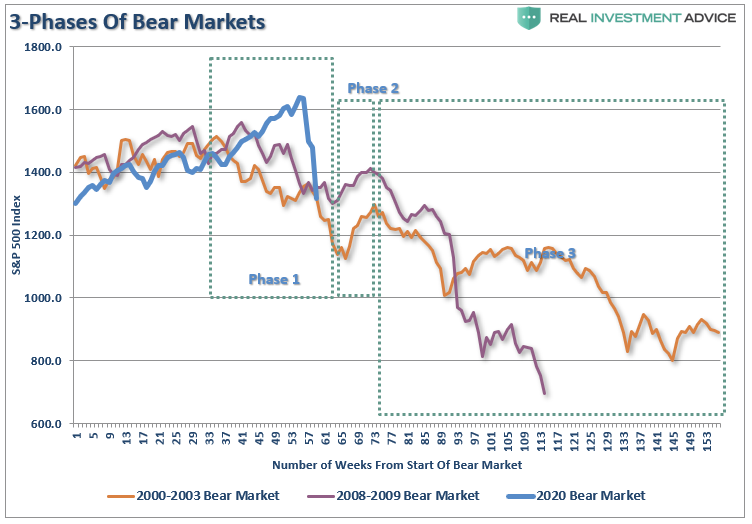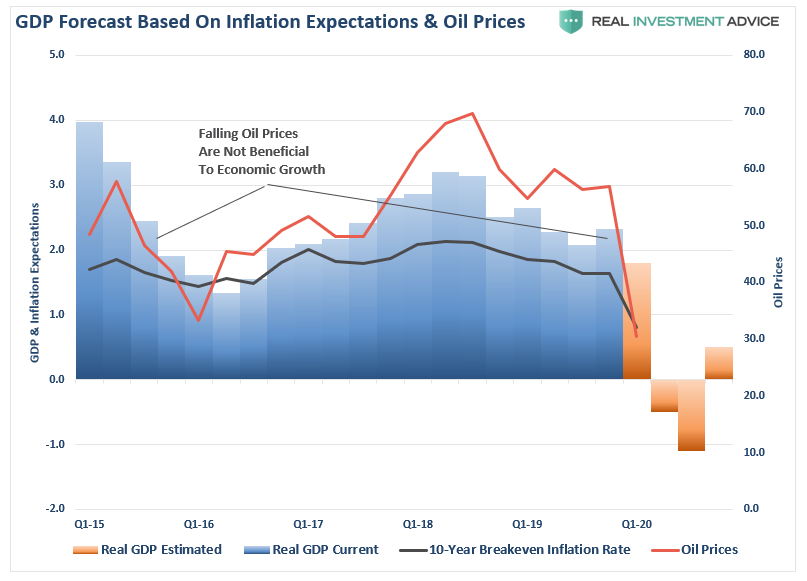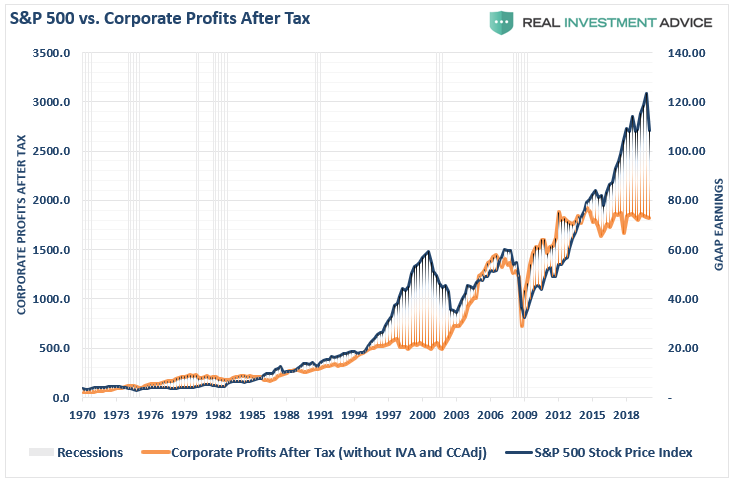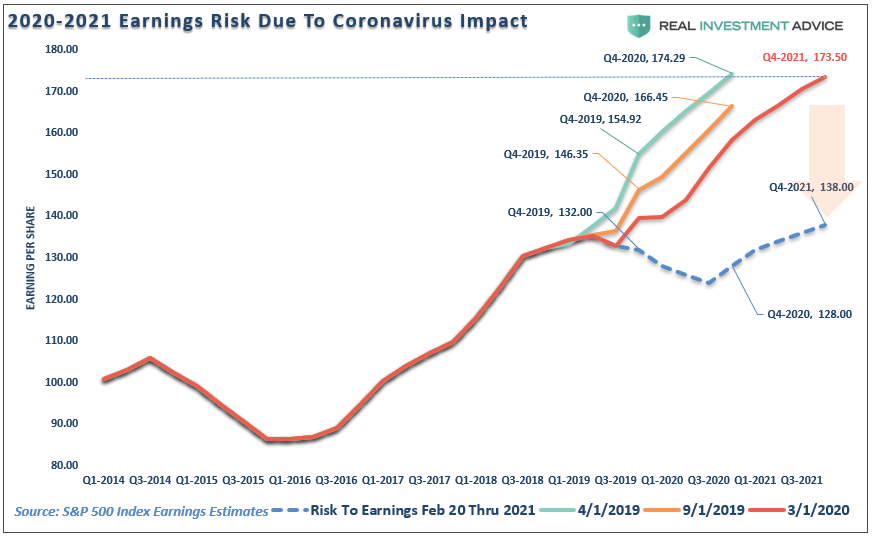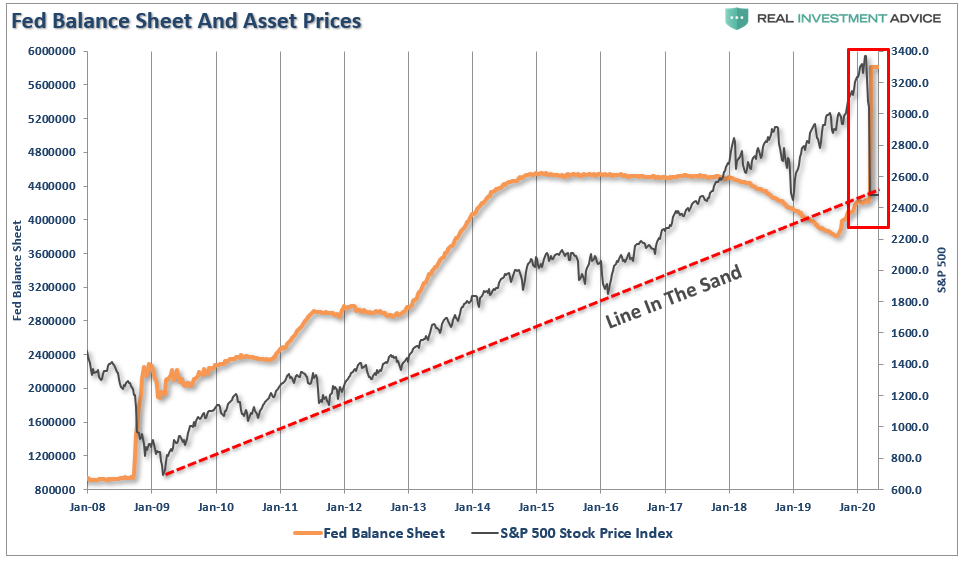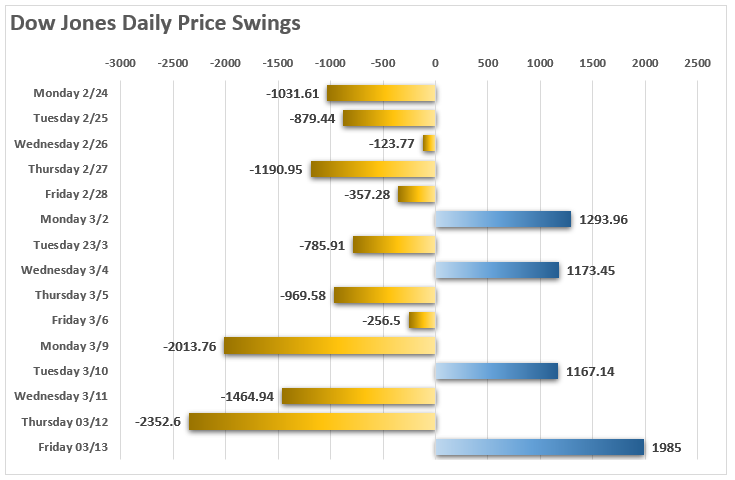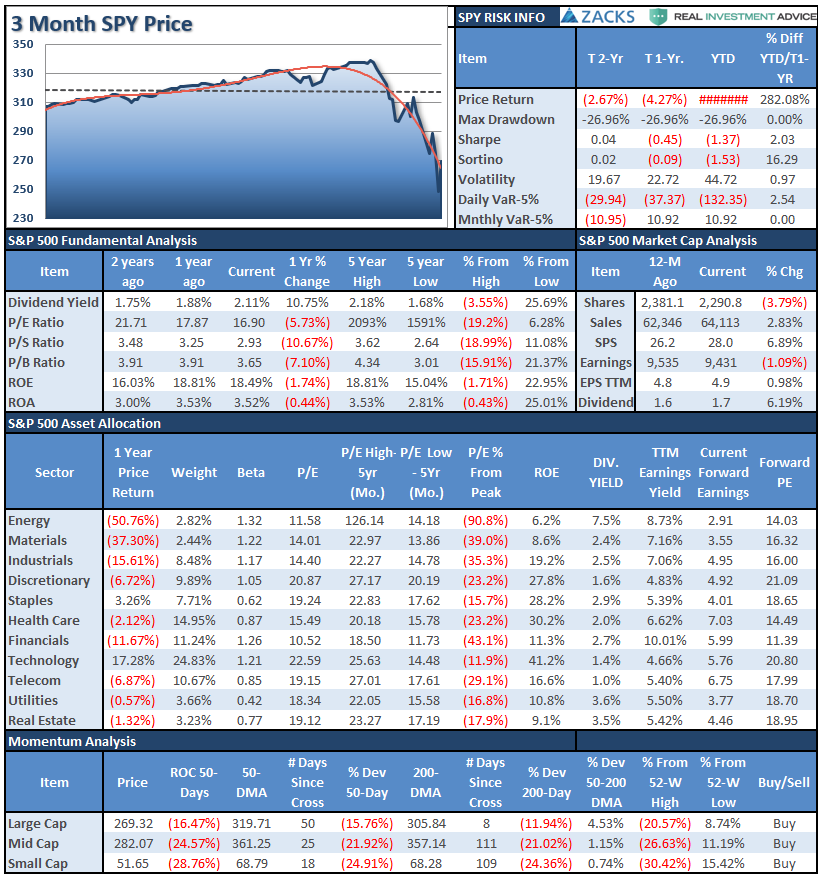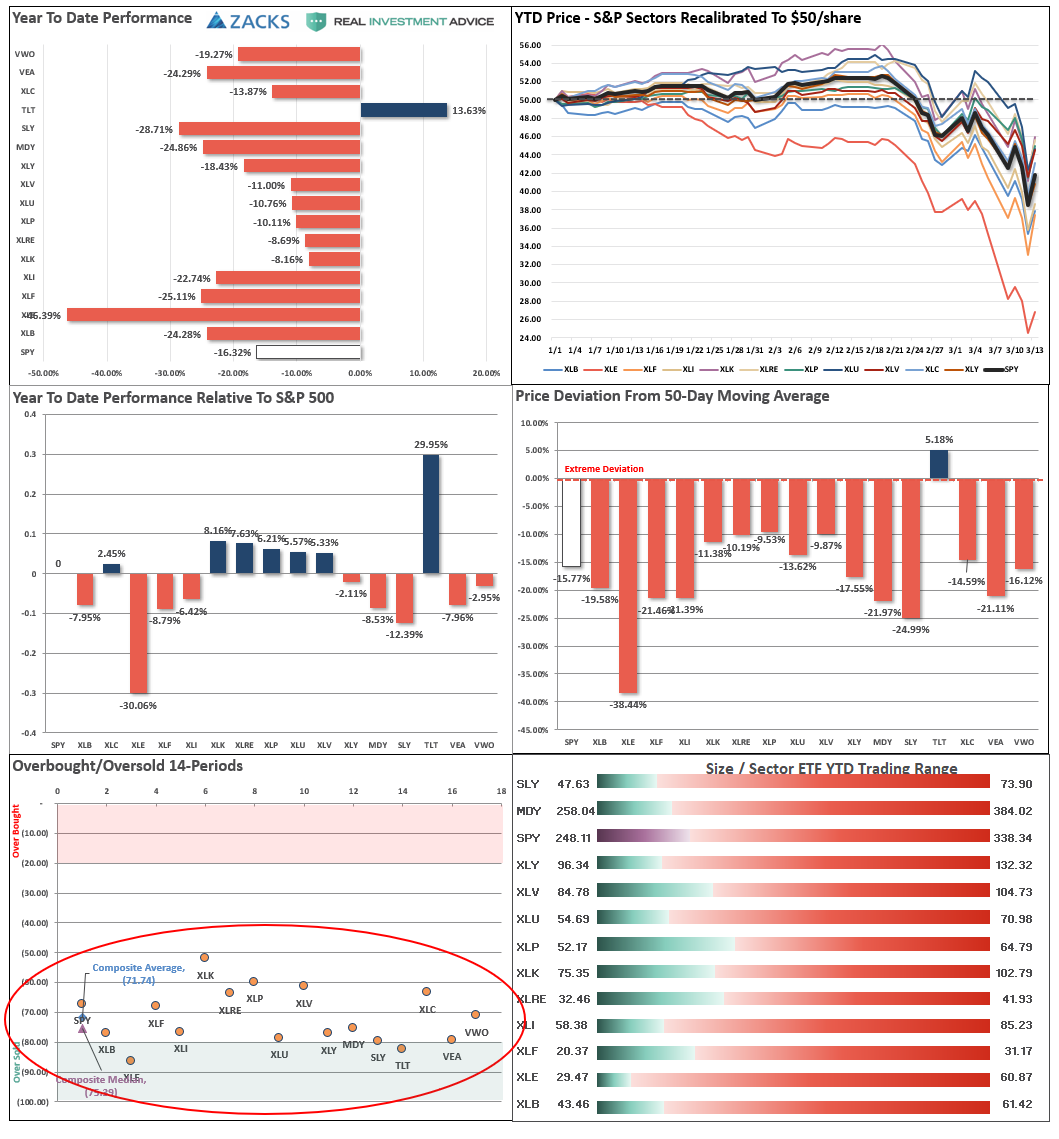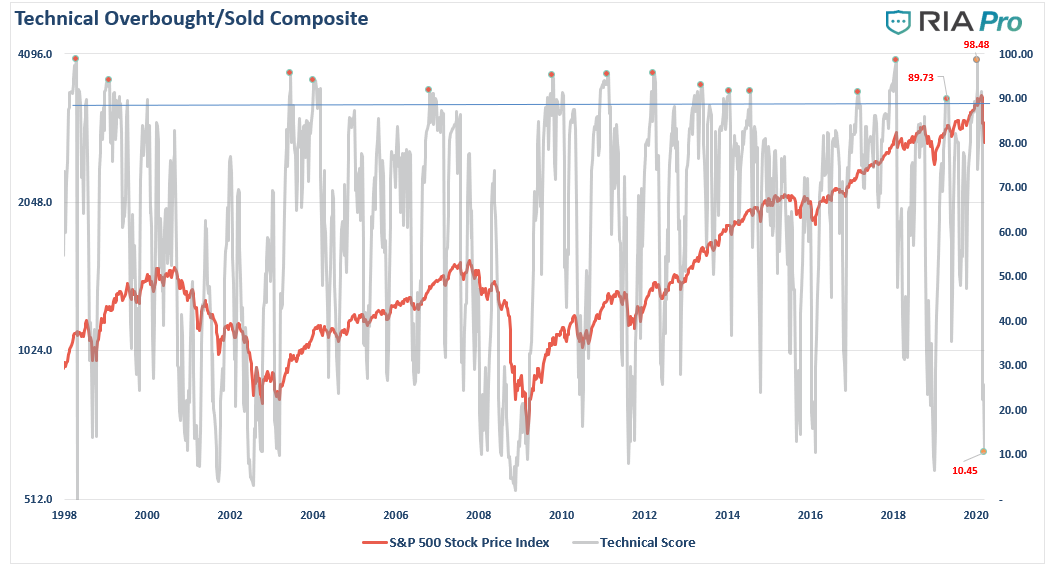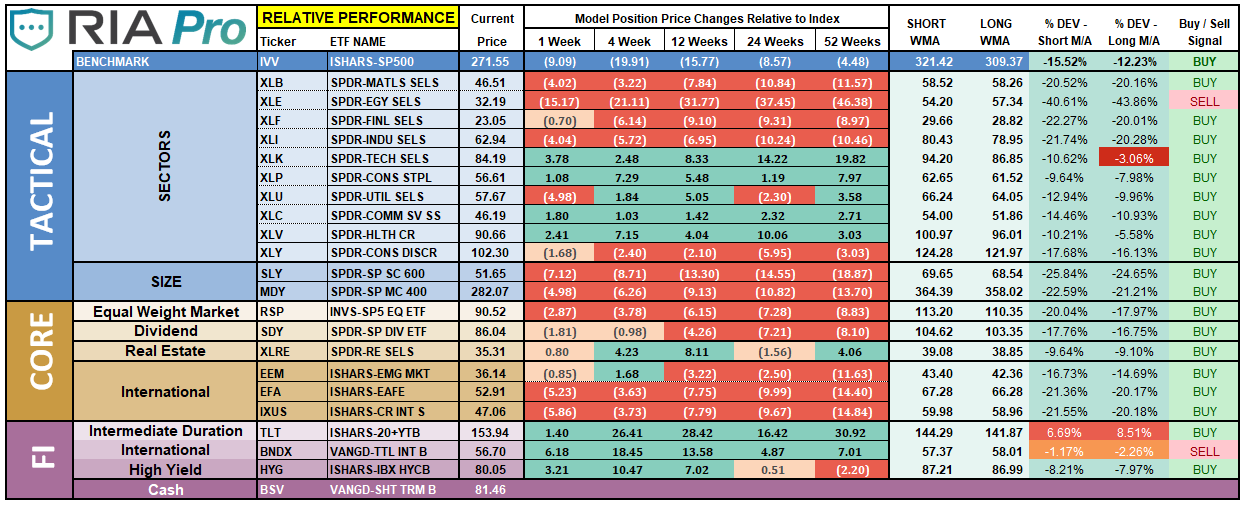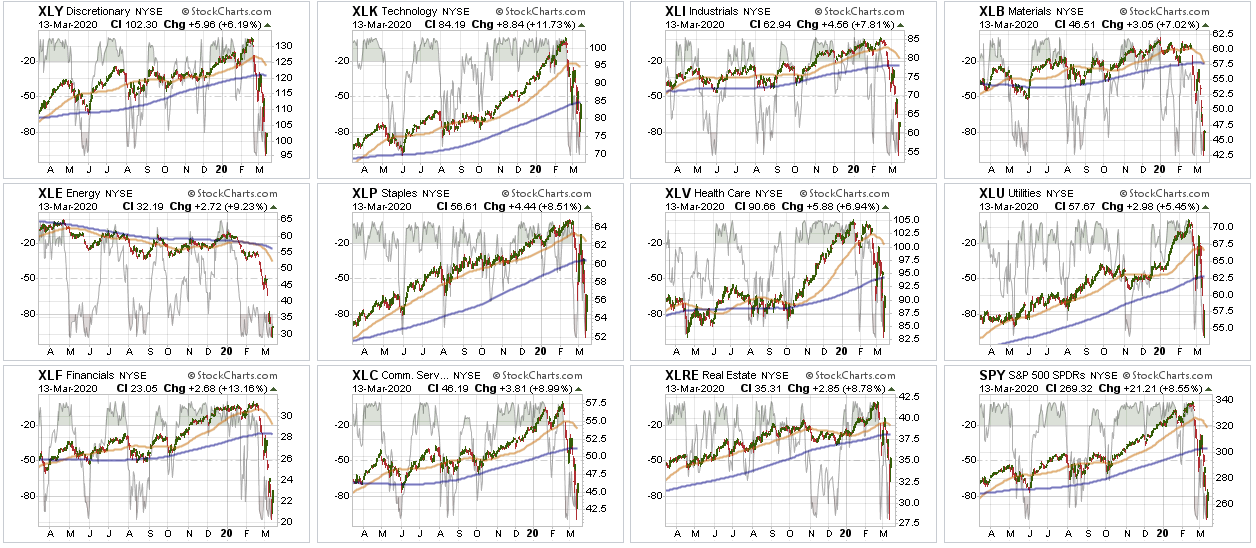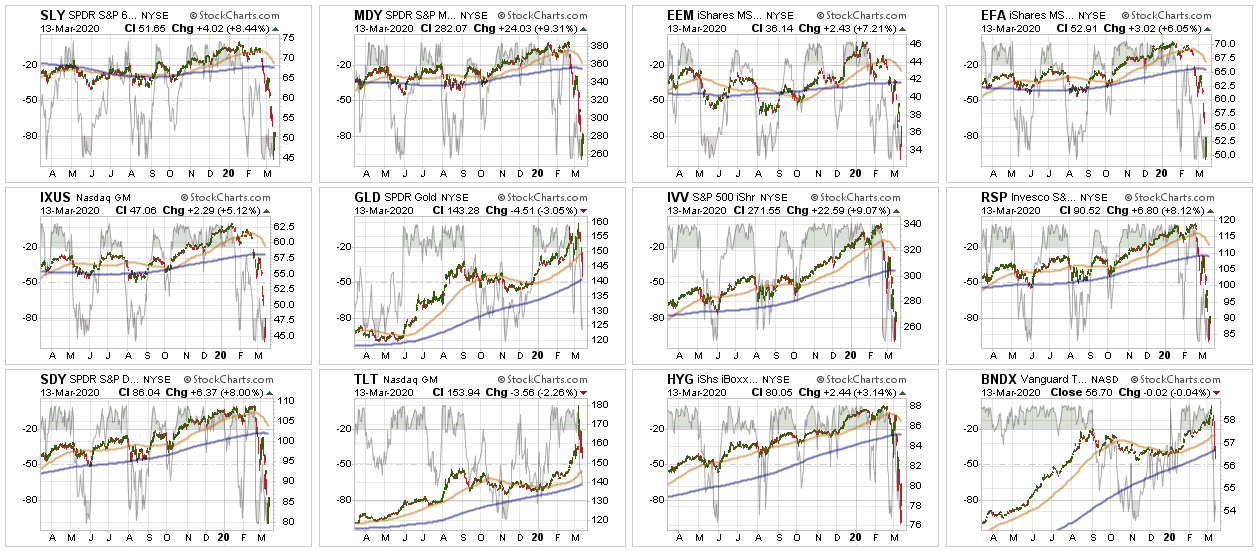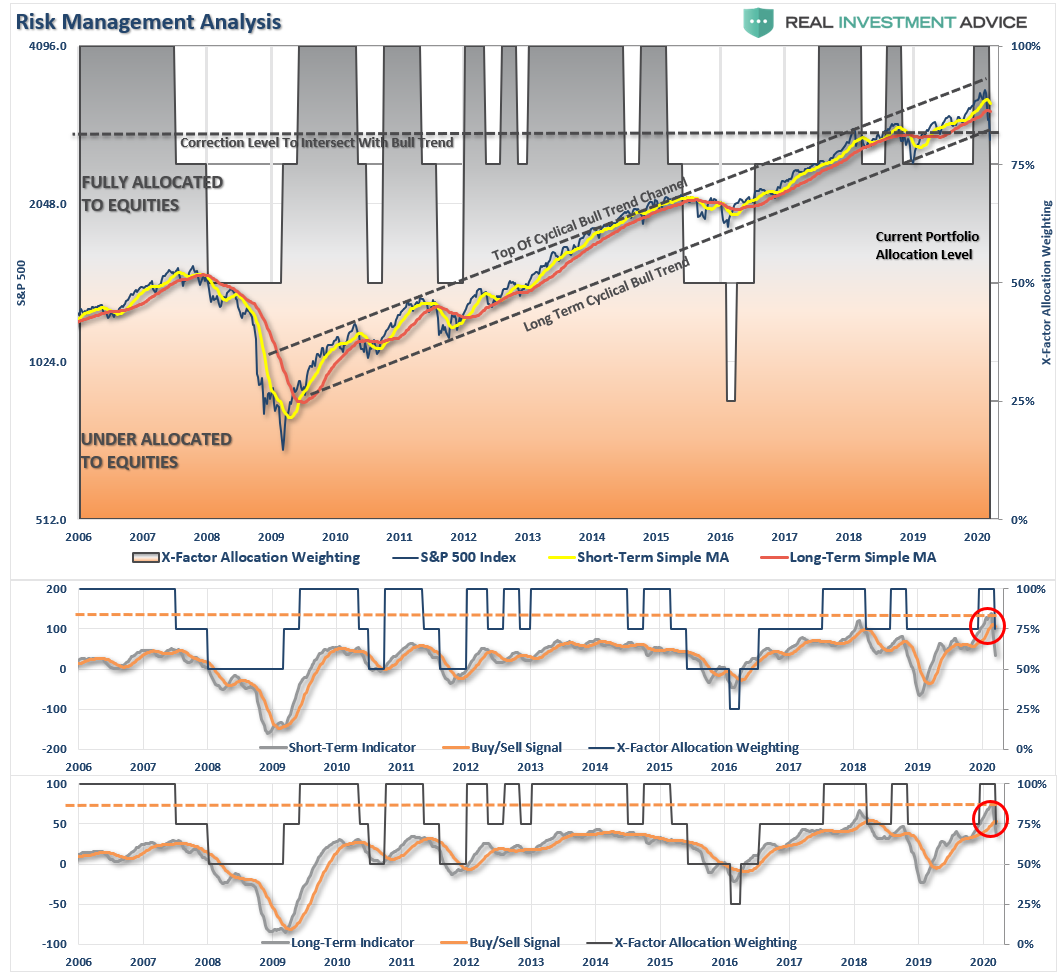Market Crash. Is It Over, Or Is It The “Revenant”
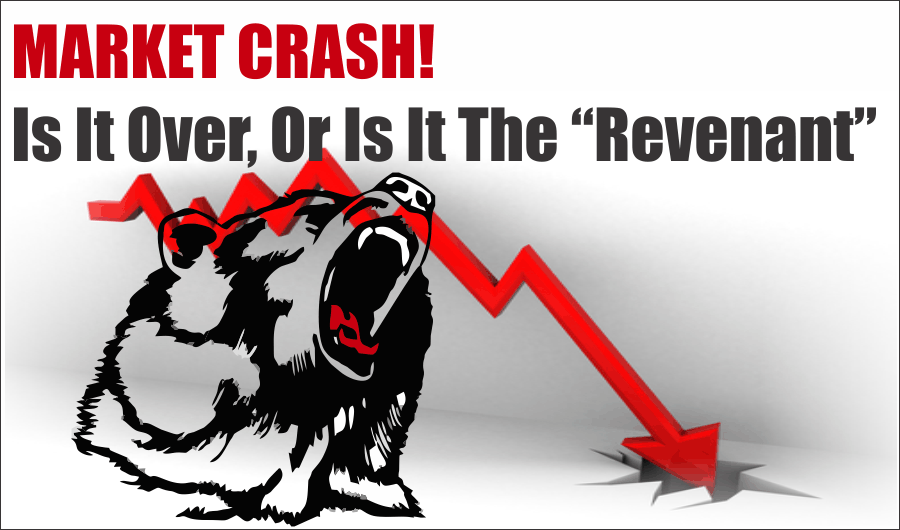
- Market Crash: Is It Over, Or Is It The Revenant?
- MacroView: Fed Launches A Bazooka To Kill A Virus
- Financial Planning Corner: Tips For A Volatile Market
- Sector & Market Analysis
- 401k Plan Manager
Follow Us On: Twitter, Facebook, Linked-In, Sound Cloud, Seeking Alpha
Catch Up On What You Missed Last Week
Market Crash. Is It Over, Or Is The “Revenant?”
If you haven’t seen the movie “The Revenant” with Leonardo DiCaprio, it is a 2015 American survival drama describing frontiersman Hugh Glass’s experiences in 1823. Early in the movie, Hugh, an expert hunter, and tracker, is mauled by a grizzly bear. (Warning: the scene is very graphic)
In the scene, the attack comes in three distinct waves.
- The bear attacks, and brutally mauls Hugh, who plays dead to survive. The attack subsides.
- The bear comes back, and Hugh shoots it, provoking the bear to maul him some more.
- Finally, Hugh pulls out his knife as the bear attacks for a final fight to the death. (Hugh wins if you don’t want to watch the video.)
Interestingly, this is also how a “bear market” works.
Bob Farrell, a legendary investor, is famous for his 10-Investment Rules to follow.
Rule #8 states:
Bear markets have three stages – sharp down, reflexive rebound and a drawn-out fundamental downtrend
- Bear markets often START with a sharp and swift decline.
- After this decline, there is an oversold bounce that retraces a portion of that decline.
- The longer-term decline then continues, at a slower and more grinding pace, as the fundamentals deteriorate.
Dow Theory also suggests that bear markets consist of three down legs with reflexive rebounds in between.
The chart above shows the stages of the last two primary cyclical bear markets versus today (the 2020 scale has been adjusted to match.)
As would be expected, the “Phase 1” selloff has been brutal.
That selloff sets up a “reflexive bounce.” For many individuals, they will “feel like” they are “safe.” This is how “bear market rallies” lure investors back in just before they are mauled again in “Phase 3.”
Just like in 2000, and 2008, the media/Wall Street will be telling you to just “hold on.” Unfortunately, by the time “Phase 3” was finished, there was no one wanting to “buy” anything.
One of the reasons we are fairly certain of a further decline is due to the dual impacts of the “COVID-19” virus, and oil price shock. As noted in our MacroView:
“With the U.S. now shutting down and entrenching itself in response to the virus, the economic impact will be worsened. However, given that economic data is lagging, and we only have numbers that were mostly pre-virus, the reports over the next couple of months will ultimately reveal the extent of the damage.
With oil prices now at $30/bbl and 10-year breakeven rates to 0.9%, the math is significantly worse, and that is what the severity of the recent selloff is telling us. Over the next two quarters, we could see as much as a 3% clip off of current GDP.”
Unfortunately, while asset prices have declined, they have likely not fully accounted for the impact to earnings, permanently lost revenues, and the recessionary impact from falling consumer confidence. Historically, the gap between asset prices and corporate profits gets filled.
In “Playing Defense: We Don’t Know What Happens Next,” I estimated the impact on earnings that is still coming.
“What we know, with almost absolute certainty, is that we will be in an economic recession within the next couple of quarters. We also know that earnings estimates are still way too elevated to account for the disruption coming from the COVID-19.”
“What we DON’T KNOW is where the ultimate bottom for the market is. All we can do is navigate the volatility to the best of our ability and recalibrate portfolios to adjust for downside risk without sacrificing the portfolio’s ability to adjust for a massive ” bazooka-style ” monetary intervention from global Central Banks if needed quickly.
This is why, over the last 6-weeks, we have been getting more “defensive” by increasing our CASH holdings to 15% of the portfolio, with our 40% in bonds doing the majority of the heavy lifting in mitigating the risk in our remaining equity holdings.
Interestingly, the Federal Reserve DID show up on Thursday as expected. In a statement from the New York Fed:
The Federal Reserve said it would inject more than $1.5 trillion of temporary liquidity into Wall Street on Thursday and Friday to prevent ominous trading conditions from creating a sharper economic contraction.
If the transactions are fully subscribed, they would swell the central bank’s $4.2 trillion asset portfolio by more than 35%.” – WSJ
As you can see in the chart below, this is a massive surge of liquidity hitting the market at a time the market is sitting on critical long-term trend support.
Of course, this is what the market has been hoping for.
- Rate cuts? Check
- Liquidity? Check
On Friday, the market surged, and ALMOST recouped the previous day’s losses. (Sorry, it wasn’t President Trump’s speech that boosted the market.)
However, this rally, and liquidity flush, most likely does not negate the continuation of the bear market. The amount of technical damage combined with a recession, and a potential surge in credit defaults almost ensures another leg of the beg market is yet to come.
A look at the charts can also help us better understand where we currently reside.

Trading The Bounce
In January, when we discussed taking profits out of our portfolios, we noted the markets were trading at 3-standard deviations above their 200-dma, which suggested a pullback, or correction, was likely.
Now, it is the same comment in reverse. The correction over the last couple of weeks has completely reversed the previous bullish exuberance into extreme pessimism. On a daily basis, the market is back to oversold. Historically, this condition has been sufficient for a bounce. Given the oversold condition (top panel) is combined with a very deep “sell signal” in the bottom panel, it suggests a fairly vicious reflexive rally is likely as we saw on Friday.
The question, of course, is where do you sell?

Looking at the chart above, it is possible for a rally to the 38.2%, or 50% retracement levels. However, with the severity of the break below the 200-dma, the 61.8% retracement level, where the 200-dma now resides, will be very formidable resistance. With the Fed’s liquidity push, it is possible for a strong “Phase 2” rally. Our plan will be to reduce equity exposure at each level of resistance and increase our equity hedges before the “Phase 3” mauling ensues.
The following chart is a longer-term analysis of the market and is the format we use for “onboarding” our clients into allocation models. (Vertical black lines are buy periods)
“But Lance, how do you know that Friday wasn’t THE bottom?”
A look at longer-term time-frames gives us some clues.
With all of our longer-term weekly “sell signals” now triggered from fairly high levels, it suggests the current selloff is not over as of yet. In other words, we will see a rally, followed by a secondary failure to lower lows, before the ultimate bottom is put in.
I have mapped out the three most logical secondary bottoms for the market, so you can assess your portfolio risk accordingly.
- A retest of current lows that holds is a 27% decline.
- A retest of the 2018 lows, most likely, is an average recessionary decline of 32.8%
- A retest of the 2016 lows, coincident with a “credit event,” would entail a 50.9% decline.
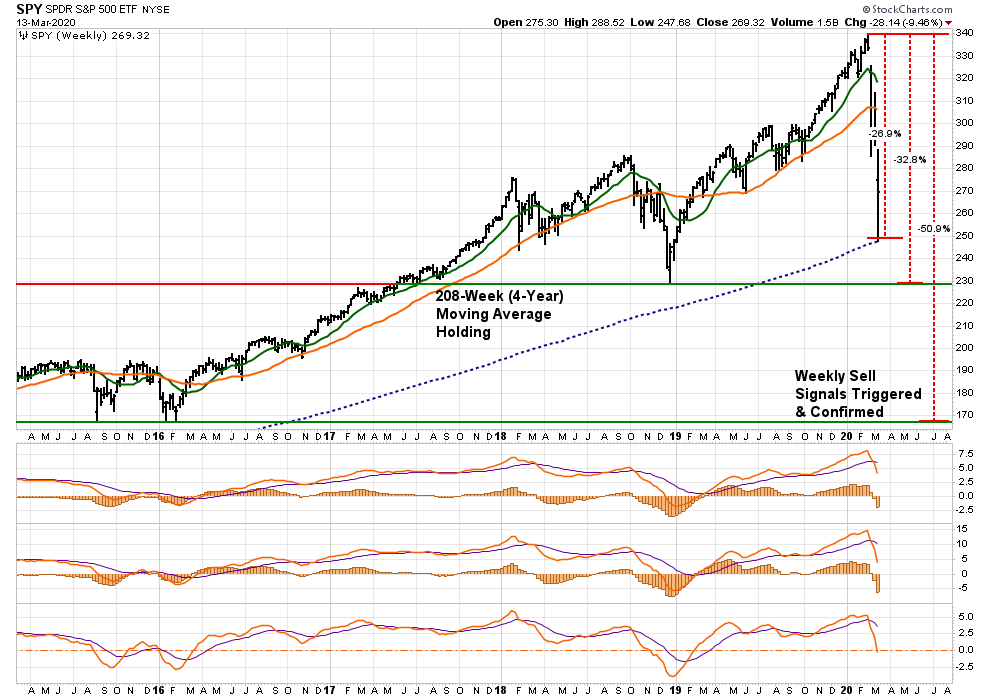
Given the weekly signals have only recently triggered, we can look at monthly data to confirm we still remain confined to a “bearish market” currently.
On a monthly basis, sell signals have been triggered. However, these signals are NOT VALID until the end of the month. However, given the depth of the decline, it would likely require a rally back to all-time highs to reverse those signals. This is a very high improbability.
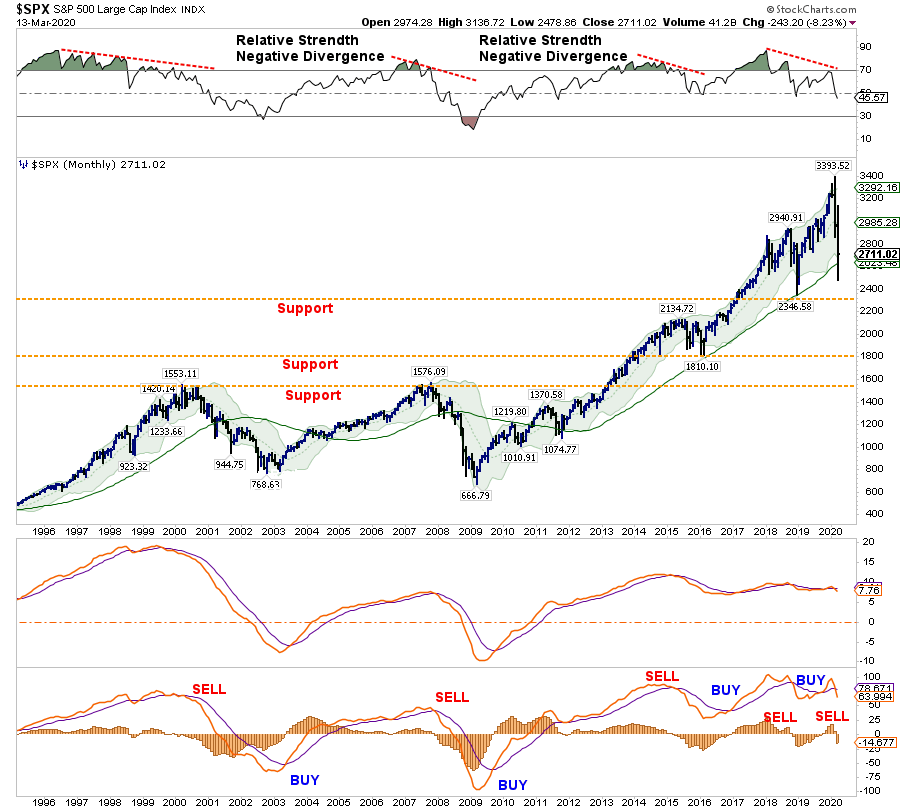
Assuming the signals remain, there is an important message being sent, as noted in the top panel. The “negative divergence” of relative strength has only been seen prior to the start of the previous two bear markets, and the 2015-2016 slog. While the current selloff resembles what we saw in late 2015, there is a risk of this developing into a recessionary bear market later this summer. The market is holding the 4-year moving average, which is “make or break” for the bull market trend from the 2009 lows.
However, we suspect those levels will eventually be taken out. Caution is advised.
What We Are Thinking
Since January, we have been regularly discussing taking profits in positions, rebalancing portfolio risks, and, most recently, moving out of areas subject to slower economic growth, supply-chain shutdowns, and the collapse in energy prices. This led us to eliminate all holdings in international, emerging markets, small-cap, mid-cap, financials, transportation, industrials, materials, and energy markets. (RIAPRO Subscribers were notified real-time of changes to our portfolios.)
There is “some truth” to the statement “that no one” could have seen the fallout of the “coronavirus” being escalated by an “oil price” war. However, there have been mounting risks for quite some time from valuations, to price deviations, and a complete disregard of risk by investors. While we have been discussing these issues with you, and making you aware of the risks, it was often deemed as “just being bearish” in the midst of a “bullish rally.” However, it is managing these types of risks, which is ultimately what clients pay advisors for.
It isn’t a perfect science. In times like these, it gets downright messy. But this is where working to preserve capital and limit drawdowns becomes most important. Not just from reducing the recovery time back to breakeven, but in also reducing the “psychological stress,” which leads individuals to make poor investment decisions over time.
As noted last week:
“Given the extreme oversold and deviated measures of current market prices, we are looking for a reflexive rally that we can further reduce risk into, add hedges, and stabilize portfolios for the duration of the correction. When it is clear, the correction, or worse a bear market, is complete, we will reallocate capital back to equities at better risk/reward measures.”
We highly suspect that we have seen the highs for the year. Most likely, we are moving into an environment where portfolio management will be more tactical in nature, versus buying and holding.
Take some action on this rally.
If this is a “Phase 2” relief rally of a bear market, you really don’t want to be around for the “final mauling.”

The MacroView
If you need help or have questions, we are always glad to help. Just email me.
See You Next Week
By Lance Roberts, CIO
Financial Planning Corner
You’ll be hearing more about more specific strategies to diversify soon, but don’t hesitate to give me any suggestions or questions.
by Danny Ratliff, CFP®
Market & Sector Analysis
Data Analysis Of The Market & Sectors For Traders
NOT A RIAPro SUBSCRIBER YET?
WE ARE UNLOCKING OUR SUBSCRIBER SECTION AGAIN THIS WEEK TO ASSIST YOU IN MANAGING YOUR PORTFOLIO IN THESE CHALLENGING TIMES.
Need to know what specifically to buy and sell in your portfolio? We cover it every week, and every day on RIA PRO along with everything we are doing in our client portfolios.
Try RISK-FREE for 30-days
S&P 500 Tear Sheet
Performance Analysis
Technical Composite
ETF Model Relative Performance Analysis
Sector & Market Analysis:
Be sure and catch our updates on Major Markets (Monday) and Major Sectors (Tuesday) with updated buy/stop/sell levels
Sector-by-Sector
Everything was crushed again this past week, so the difference between leading and lagging sectors is which sector fell faster or slower than the S&P 500 index itself.
Improving – Discretionary (XLY), Real Estate (XLRE), and Staples (XLP)
Last week, we rebalanced our weightings in Real Estate and Staples, as these sectors are now improving in terms of relative performance. After getting very beaten up, we are looking not only for the “risk hedge” of non-virus related sectors but an eventual outperformance of the groups.
We sold our entire stake in Discretionary due to potential earnings impacts from a slowdown in consumption, supply chain problems, and inventory issues. This worked well as Discretionary fell sharply last week.
Current Positions: Target Weight XLU, XLRE
Outperforming – Technology (XLK), Communications (XLC), and Utilities (XLU)
The correction in Technology this past week broke support at the 200-dma but finished the week very close to our entry point, where we had slightly increased our exposure. These have “anti-virus” properties, so we are looking for the “risk hedge” relative to the broader market. Communication and Utilities didn’t perform as well but also held up better during the decline on a relative basis. We are watching Utilities and may reduce exposure if interest rates begin to rise due to the Fed. The same with Real Estate as well.
Current Positions: Target weight XLK, XLC, XLU
Weakening – Healthcare (XLV)
We did bring our healthcare positioning back to portfolio weight as the sector will ultimately benefit from a “cure” for the “coronavirus.” Also, with Bernie Sanders now lagging Joe Biden on the Democratic ticket, this removes some of the risks of “nationalized healthcare” from the sector.
Current Position: Target weight (XLV)
Lagging – Industrials (XLI), Financials (XLF), Materials (XLB), and Energy (XLE)
We had started to buy a little energy exposure previously but closed out of the positions as we were stopped out of our holdings week before last. We are going to continue to monitor the space due to its extreme oversold condition and relative value and will re-enter our positions when stability starts to take hold.
We also sold Financials due to the financial risk from a recessionary impact on the outstanding corporate debt which currently exists. The Fed’s rate cut also impacts the bank’s Net Interest Margins, which makes them less attractive. Industrials and Materials have too much exposure to the “virus risk” for now.
Current Position: None
Market By Market
Small-Cap (SLY) and Mid Cap (MDY) – Week before last, we sold all small-cap and mid-cap exposure over concerns of the impact of the coronavirus. Remain out of these sectors for now. However, given that Central Banks are going “all in” on stimulus, we may look for a trade in these sectors short-term.
Current Position: None
Emerging, International (EEM) & Total International Markets (EFA)
Same as small-cap and mid-cap. Given the spread of the virus and the impact on the global supply chain. Trading opportunity only.
Current Position: None
Dividends (VYM), Market (IVV), and Equal Weight (RSP) – We have decided to consolidate our long-term “core” holding into IVV only. We sold RSP and VYM and added to IVV. The reason for doing this is the disparity of performance between the 3-holdings. Since we want an “exact hedge” for our portfolio, IVV is the best match for a short-S&P 500 ETF.
Current Position: IVV
Gold (GLD) – This past week, Gold sold off as the Fed introduced liquidity giving the bulls hope and removing the “fear” factor in stocks. There was also a massive “margin call” that led to a liquidation event. Gold is VERY oversold currently. Add positions to portfolios with a stop $140. We sold our GDX position due to the fact mining is people-intensive and is located in countries most susceptible to the virus.
Current Position: IAU (GOLD)
Bonds (TLT) –
Bonds also broke out to new highs as the correction ensued. Last Friday, we took profits in our 20-year bond position (TLT) to reduce our duration slightly, raise cash, and take in some profits. Bonds are extremely overbought now, so be cautious, we are maintaining the rest of our exposures for now, but we did rebalance our duration by selling 1/2 of IEF and adding to BIL.
Current Positions: DBLTX, SHY, IEF, PTIAX, BIL
Sector / Market Recommendations
The table below shows thoughts on specific actions related to the current market environment.
(These are not recommendations or solicitations to take any action. This is for informational purposes only related to market extremes and contrarian positioning within portfolios. Use at your own risk and peril.)
Portfolio/Client Update:
Thank goodness. The market finally responded to the Fed on Friday.
Please read “Trading The Bounce” above as it details our plan on how we are going to trade this liquidity rally.
As noted last week:
“Staying true to our discipline and strategy is difficult when you have this type of volatility. We question everything, every day. Are we in the right place? Do we have too much risk? Are we missing something?
The ghosts of 2000, and 2008, stalk us both, and we are overly protective of YOUR money. We do not take our jobs lightly.”
We took some further actions to increase cash, further rebalance risks this past week. We are now using this rally to add hedges, and reduce equities until the current “sell signals” reverse. As noted, this is most likely a “bear market” rally that will fail.
However, if it is the beginning of a new “bull market,” then we will simply remove hedges and add to our equity longs.
Be assured we are watching your portfolios very closely. However, if you have ANY questions, comments, or concerns, please don’t hesitate to email me.
Portfolio Actions Taken Last Week
- New clients: Only adding new positions as needed.
- Dynamic Model: Sold VOOG, and hedged portfolio. Currently unhedged.
- Equity Model: Sold IEF and added to BIL to shorten bond portfolio duration. Sold RSP and VYM, and added slightly to IVV to rebalance our CORE holdings for more effective hedges.
- ETF Model: Same as Equity Model.
Note for new clients:
It is important to understand that when we add to our equity allocations, ALL purchases are initially “trades” that can, and will, be closed out quickly if they fail to work as anticipated. This is why we “step” into positions initially. Once a “trade” begins to work as anticipated, it is then brought to the appropriate portfolio weight and becomes a long-term investment. We will unwind these actions either by reducing, selling, or hedging if the market environment changes for the worse.
THE REAL 401k PLAN MANAGER
A Conservative Strategy For Long-Term Investors
Model performance is based on a two-asset model of stocks and bonds relative to the weighting changes made each week in the newsletter. This is strictly for informational and educational purposes only and should not be relied upon for any reason. Past performance is not a guarantee of future results. Use at your own risk and peril.
401k Plan Manager Live Model
As an RIA PRO subscriber (You get your first 30-days free) you have access to our live 401k p
The code will give you access to the entire site during the 401k-BETA testing process, so not only will you get to help us work out the bugs on the 401k plan manager, you can submit your comments about the rest of the site as well.
We are building models specific to company plans. So, if you would like to see your company plan included specifically, send me the following:
- Name of the company
- Plan Sponsor
- A print out of your plan choices. (Fund Symbol and Fund Name)
If you would like to offer our service to your employees at a deeply discounted corporate rate, please contact me.








